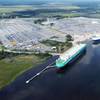GDP v TEU: DMR Analyses the Interplay
The strength of first-half 2014 container flows from Asia to Europe flies in the face of the macro-economic data coming out of Europe, says Drewry Maritime Research (DMR) in their latest ‘Container Insight Weekly’, excerpted here.
As highlighted in last week’s analysis by DMR of the Asia-North Europe trade, disappointing recent economic news coming out of Europe does not chime with the robust growth reported for some of the big ocean container markets.
Eurozone GDP flat-lined in the second-quarter as its three largest economies; Germany, France and Italy all stuttered. Germany, which accounts for roughly one-third of the entire Eurozone economy, contracted at an annualised 0.6% in the second quarter, held back by weaker exports, while France reported a 0.1% fall, forcing the government to concede that it will not reach its annual growth or budget deficit targets. Italy slipped back into recession as the economy contracted for the second quarter in a row, this time falling by 0.8%.
There are some bright spots in Europe with Spain, Portugal and the Netherlands all posting annualised GDP growth over 2%, while outside the currency zone the UK was up by 3.4%.
In Asia, China continues to set the pace with second quarter GDP growth of 8.2%, but the Japanese economy fell by 6.8%, its worst performance since the tsunami in 2011.
These are not the sort of economic statistics that would have suggested the good times were coming back to the container sector, yet first-half growth in the largest deep-sea trade from Asia to Europe and the Mediterranean (including North Africa) reached 8% year-on-year.
So, how to explain these seemingly conflicting trends? The first thing to acknowledge is that using GDP to forecast container flows has its limitations. As the broadest measure of economic health GDP is one of the drivers of long-term aggregate growth in trade, but can be a poor guide when making predictions on short-term trade prospects.
As much as international trade feeds GDP and vice versa, GDP also reflects changes in domestic economic activity not related to exports and imports and other economic inputs such as investment and productivity. Moreover, container traffic growth is influenced by factors other than GDP, including the multiple physical transport of parts, intermediate goods and finished goods and the increasing containerisation of certain commodities.
The shortcomings of GDP increase when trying to forecast container volumes at the trade route level. Currency exchange rates, supplier prices, inventory restocking, trade imbalances and transport costs can all have a dramatic effect on short-run volumes.
GDP is a lagging indicator and market expectations can affect international trade. If the market expects a recovery, consumers will change their spending habits, which can lead to higher demand and translate to higher international trade, eventually feeding back into economic growth. While the second-quarter GDP growth rates around Europe were largely disappointing, better is expected for the full year, and it could be that the stronger container flows of the first half are a precursor to improved GDP.
The second thing to consider when squaring the high container/low GDP growth conundrum is: how is the data being interpreted? Monthly, and even quarterly, trade statistics are prone to large growth swings as year-on-year comparisons can be skewed by a range of factors, from movable national holiday dates in China to shipments being brought forward to avoid General Rate Increases or port labour issues, as seen recently on the US West Coast.
The fixation on y-o-y growth patterns can lead to misinterpretation of the underlying trend. The 8% growth for westbound Asia-Europe at first glance looks very impressive and well beyond what Drewry predicted for the full-year. However, the first and second quarters in 2013 were weak with volumes roughly at the same level as in 2011 so growth this year has come off a low base.
Drewry’s View
Growth in the Asia-Europe trade during the first-half was inflated by weak year-earlier comparisons, yet there is no denying the strength is beyond expectations despite weak GDP economic indicators. Looking forward, we expect the container trade growth rate to slow and for the economy to catch up.
The full GDP v TEU report can be accessed at http://bit.ly/1qzrKKc
Source: Drewry Maritime Research










